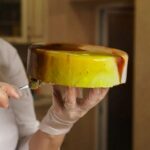Are you looking to elevate your cake decorating game? Learn how to make chocolate sheets for cake decorating and add a touch of elegance to your creations. Chocolate sheets are not only visually stunning, but they also add a rich and decadent flavor to any dessert. Whether you’re a professional baker or just enjoy experimenting in the kitchen, mastering the art of making chocolate sheets will take your confectionary skills to the next level.
Chocolate sheets have become a popular choice for cake decorators due to their versatility and ability to add depth and texture to cakes, cupcakes, and other desserts. From elegant wedding cakes to whimsical birthday treats, chocolate sheets can be molded and shaped into various designs that suit any occasion. In this article, we’ll explore the process of creating these delectable decorations, from choosing the right type of chocolate to troubleshooting common issues that may arise during the making process.
With the right techniques and tips, you can learn how to properly temper chocolate, create smooth and even chocolate sheets, and even add unique flavors and colors for a personalized touch. Whether you’re new to working with chocolate or a seasoned pro, there’s something in this article for everyone looking to enhance their cake decorating repertoire.
So let’s dive into the world of chocolate making and discover how you can use handmade chocolate sheets to take your cake decorating skills up a notch.
Choosing the Right Chocolate
When it comes to making chocolate sheets for cake decorating, choosing the right type and quality of chocolate is crucial. Different types of chocolate have different properties that will affect the final result of your chocolate sheets. Here are some considerations to keep in mind when selecting the chocolate for your project:
- Dark Chocolate: Dark chocolate is a popular choice for making chocolate sheets due to its rich flavor and smooth texture. Look for dark chocolate with a high cocoa content (around 70% or higher) for best results.
- Milk Chocolate: Milk chocolate can be used to make lighter-colored chocolate sheets, perfect for certain cake designs or when a less intense chocolate flavor is desired.
- White Chocolate: White chocolate can add a beautiful contrast to dark or milk chocolate cakes. Be sure to use high-quality white chocolate that contains cocoa butter for the best results.
In addition to considering the type of chocolate, pay attention to the quality of the ingredients. Using high-quality, real chocolate rather than imitation or compound chocolate will result in better flavor and texture. Look for chocolates with simple ingredients and no added fillers or preservatives.
Properly melting and tempering the chosen chocolate is essential for creating smooth, glossy, and stable chocolate sheets. Pay attention to the tempering process detailed in the previous section to ensure that your chocolate sheets turn out perfectly every time.
For anyone interested in taking their cake decorating skills up a notch or adding an extra special touch to their baked creations, learning how to make and use homemade Chocolate Sheets could be game-changing.
From incorporating unique flavors and colors into your Chocolate Sheets that match any occasion’s color scheme or theme – like using peppermint extract during Christmas, rose water during Valentine’s Day, Lemon Zest during summer – one can create personalized decorations on their cakes that store-bought options simply cannot offer.
Steps to Temper Chocolate Properly for Making Chocolate Sheets
Tempering chocolate is an essential step in creating chocolate sheets for cake decorating. Proper tempering ensures that the chocolate has a smooth texture, glossy finish, and a satisfying snap when broken. To begin, you will need high-quality chocolate that contains at least 70% cocoa solids. The type of chocolate you choose, whether dark, milk, or white, will determine the flavor and color of your chocolate sheets.
The first step in tempering chocolate is to finely chop it into small, uniform pieces. This allows the chocolate to melt evenly and prevents any lumps from forming. Next, place about three-quarters of the chopped chocolate in a heatproof bowl set over a pot of simmering water. Use a candy thermometer to monitor the temperature and heat the chocolate to around 115°F (46°C) for dark chocolate or 110°F (43°C) for milk or white chocolate.
Once the chocolate has reached the desired temperature, remove it from the heat and add the remaining quarter of chopped chocolate. This process is known as “seeding” and helps to lower the temperature of the melted chocolate while introducing stable cocoa butter crystals from the added pieces.
Stir the chocolate continuously until all the added pieces have melted, bringing the temperature down to 82-84°F (28-29°C) for dark chocolate or 80-82°F (27-28°C) for milk or white chocolate. Once tempered, your chocolate is ready to be spread into thin sheets for cake decorating.
| Chocolate Type | Tempering Temperature Range |
|---|---|
| Dark | 115°F (46°C) – Cooling to 82-84°F (28-29°C) |
| Milk/White | 110°F (43°C) – Cooling to 80-82°F (27-28°C) |
Creating a Smooth and Even Chocolate Sheet
When making chocolate sheets for cake decorating, achieving a smooth and even finish is essential for the overall look of the final product. To start, it is important to use high-quality chocolate that melts easily and evenly. Dark, milk, or white chocolate can be used depending on the desired flavor and color of the sheet. It’s also crucial to properly temper the chocolate to ensure that it sets correctly and maintains a glossy appearance.
Once the chocolate has been tempered, there are several techniques that can be used to create a smooth and even sheet. One popular method is to spread the melted chocolate onto a parchment-lined baking sheet using an offset spatula.
This allows for control over the thickness of the sheet and helps ensure that it sets evenly. Another technique is to pour the tempered chocolate onto a marble slab or other flat surface and use a bench scraper to spread it into an even layer.
In addition to technique, it is important to work quickly when spreading the chocolate to prevent any uneven spots or lines from forming. Using long, smooth strokes with whatever tool you choose will help create an even finish. Once the sheet has been created, it should be left to set at room temperature until firm, but not completely hardened, making it easier to cut or shape as needed.
| Technique | Benefits |
|---|---|
| Spreading with offset spatula | Allows for control over thickness; ensures even setting |
| Pouring onto marble slab | Creates an ultra-smooth surface; easy to spread evenly |
| Working quickly with long strokes | Prevents uneven spots or lines from forming; creates an even finish |
Adding Flavors and Colors to Chocolate Sheets for a Personalized Touch
When it comes to cake decorating, adding flavors and colors to chocolate sheets can take your creations to the next level. Not only does it add a personalized touch, but it also allows you to tailor your chocolate sheets to complement the flavor of your cake. There are endless possibilities when it comes to infusing flavors into chocolate sheets, from classic options like vanilla and almond, to more unique choices such as lavender or espresso.
To add flavor to your chocolate sheets, start by choosing high-quality extracts or oils that pair well with the type of chocolate you are using. For example, if you are working with dark chocolate, consider using orange or peppermint extract for a refreshing twist. Simply mix the desired amount of flavoring into your tempered chocolate before spreading it onto a parchment-lined baking sheet, then follow the usual steps for creating chocolate sheets.
In addition to adding flavor, incorporating colors into your chocolate sheets can create stunning visual effects in your cake decorating. You can use gel food coloring specifically designed for use with chocolate to achieve vibrant and bold colors.
Whether you want pastel hues for a baby shower cake or rich jewel tones for a special occasion dessert, coloring your chocolate sheets opens up endless creative possibilities in cake design. By carefully selecting complementary flavors and colors for your chocolate sheets, you can truly elevate the overall aesthetic and taste of your decorated cakes.
Using Chocolate Sheets in Cake Decorating
When it comes to using chocolate sheets in cake decorating, the possibilities are endless. From adding a touch of elegance to creating intricate designs, chocolate sheets can take your cake decorating to the next level. Here are some application and design ideas for using chocolate sheets:
1. Wrap-around Designs: Create stunning wrap-around designs by cutting the chocolate sheets into long strips and gently wrapping them around the sides of your cake. This technique works well for layer cakes and adds a professional touch to your presentation.
2. Cut-Outs and Shapes: Use cookie cutters or stencils to create various shapes and designs with chocolate sheets. Whether you’re making flowers, hearts, or geometric patterns, the flexibility of chocolate sheets allows for intricate detailing on your cakes.
3. Textured Backgrounds: Give your cakes a textured background by laying a sheet of chocolate over the entire surface before adding other decorations. You can create a marble effect, a speckled pattern, or simply add some depth to your cake’s appearance.
By incorporating these application and design ideas, you can elevate the look of your cakes and desserts with handmade chocolate sheets. Whether you’re working on a simple birthday cake or an elaborate wedding dessert, chocolate sheets offer a creative and versatile way to enhance your cake decorating skills.
Storing Chocolate Sheets for Future Use and Longevity
Proper Storage Containers and Conditions
After creating beautiful chocolate sheets for cake decorating, it’s essential to store them properly to maintain their quality and integrity. The best way to store chocolate sheets is by placing them in an airtight container, such as a plastic or glass food storage container, with a layer of parchment paper between each sheet to prevent sticking.
It’s important to keep the chocolate sheets in a cool, dry place away from direct sunlight and moisture to avoid any melting or discoloration.
Freezing Chocolate Sheets
If you want to extend the shelf life of your chocolate sheets, consider freezing them. Wrap the sheets tightly in plastic wrap or place them in a resealable freezer bag before storing them in the freezer. When properly stored, chocolate sheets can last for several months in the freezer without compromising their taste or texture. To thaw frozen chocolate sheets, simply transfer them to the refrigerator and let them defrost slowly before using them for cake decorating.
Avoiding Odor Contamination
To ensure that your chocolate sheets retain their original flavor and aroma, store them away from strong-smelling foods or ingredients. Chocolate easily absorbs odors, so it’s best to keep them separate from pungent items like garlic, onions, or spices. Additionally, consider using odor-absorbing products such as activated charcoal or baking soda within the storage container to help maintain the purity of the chocolate’s flavor.
By following these storage guidelines, you can preserve your handmade chocolate sheets for future use while maintaining their quality and taste. Properly stored chocolate sheets will be ready whenever you need an elegant touch for your cake decorating creations.
Troubleshooting
Chocolate Not Setting Properly
If you find that your chocolate is not setting properly when attempting to make chocolate sheets, it could be due to improper tempering. The most common reasons for this issue are either the chocolate was overheated during the melting process or the temperature was not lowered enough during the tempering process.
To fix this problem, you can try adding more tempered chocolate to the mixture and re-tempering it, or if the chocolate has already been poured onto a sheet, you can try placing it in the refrigerator to cool and set properly.
Chocolate Sheets Cracking or Breaking
One of the most frustrating issues when making chocolate sheets is when they crack or break during handling. This often occurs due to the chocolate being too thin or uneven in certain areas.
To fix this issue, you can try gently heating a metal spatula on a warm stove burner and then using it to smooth over any cracks or breaks in the chocolate sheet. Additionally, ensuring that your chocolate sheet is thick enough and evenly spread out on your non-stick surface before setting can also prevent this problem.
Chocolate Sheets Sticking to Surface
Another common issue with making chocolate sheets is when they stick to the surface they were set on. This could be due to not using enough non-stick spray or not having a smooth and clean surface.
If you encounter this issue, carefully use an offset spatula or knife to gently loosen the edges of the sheet from the surface. You can also try placing the surface in the freezer for a few minutes, as sometimes cooling it down can help release the chocolate more easily.
By troubleshooting these common issues, you can ensure that your handmade chocolate sheets come out perfectly every time, allowing you to elevate your cake decorating with professional-looking and personalized designs.
Conclusion
In conclusion, learning how to make chocolate sheets for cake decorating is a skill that can truly elevate your baking game. By mastering the art of choosing the right chocolate, tempering it properly, and creating smooth and flavorful chocolate sheets, you can add a personalized and professional touch to your cakes and desserts. With the ability to customize flavors and colors, as well as apply unique designs, you can take your cake decorating to a whole new level.
Furthermore, utilizing handmade chocolate sheets in your cake decorating not only adds visual appeal but also brings an extra layer of richness and taste to your creations. Whether you’re decorating a birthday cake, wedding cake, or any other special dessert, incorporating chocolate sheets can set your baked goods apart and impress your guests or customers. Additionally, by learning how to properly store chocolate sheets for future use, you can always have this versatile decoration on hand for any occasion.
Overall, the possibilities with handmade chocolate sheets are endless when it comes to cake decorating. From simple yet elegant designs to intricate patterns and bold flavors, incorporating these unique elements can truly set your creations apart.
By following the techniques and tips outlined in this article, you can hone your skills in making chocolate sheets and take your cake decorating to new heights. So don’t be afraid to experiment with different chocolates, flavors, colors, and designs – let your creativity shine through in every sweet creation.
Frequently Asked Questions
How to Make Chocolate Bark for Cake Decorating?
To make chocolate bark for cake decorating, start by melting chocolate and spreading it in a thin layer on parchment paper. Add your desired toppings, such as nuts or dried fruit, and let it cool until hard.
Once the chocolate is set, break it into irregular pieces to create the bark effect. You can then use these chocolate bark pieces to decorate cakes by arranging them on top or around the sides of the cake.
How Do You Make Thin Chocolate Sheets?
Making thin chocolate sheets involves tempering the chocolate first, then spreading it thinly over a large flat surface, such as a marble slab or a baking sheet lined with parchment paper. Allow the chocolate to set partially before cutting it into desired shapes or sizes using a sharp knife or cookie cutters.
The thin chocolate sheets can be used for various cake decorating techniques, like wrapping them around cake tiers for an elegant finish.
Which Chocolate Is Used for Cake Decorating?
For cake decorating, it’s best to use high-quality dark or semi-sweet chocolate with a cocoa content of at least 70%. This type of chocolate melts smoothly and has a rich flavor that complements many different types of cakes.
Additionally, you can also use white chocolate for contrast if you’re looking to add visual interest to your cake decorations. Just be sure that any type of chocolate you choose is tempered properly to achieve the best results in cake decorating projects.

Welcome to my blog about home and family. This blog is a place where I will share my thoughts, ideas, and experiences related to these important topics. I am a stay-at-home mom with two young children. I hope you enjoy reading it! and may find some helpful tips and ideas that will make your home and family life even better!





